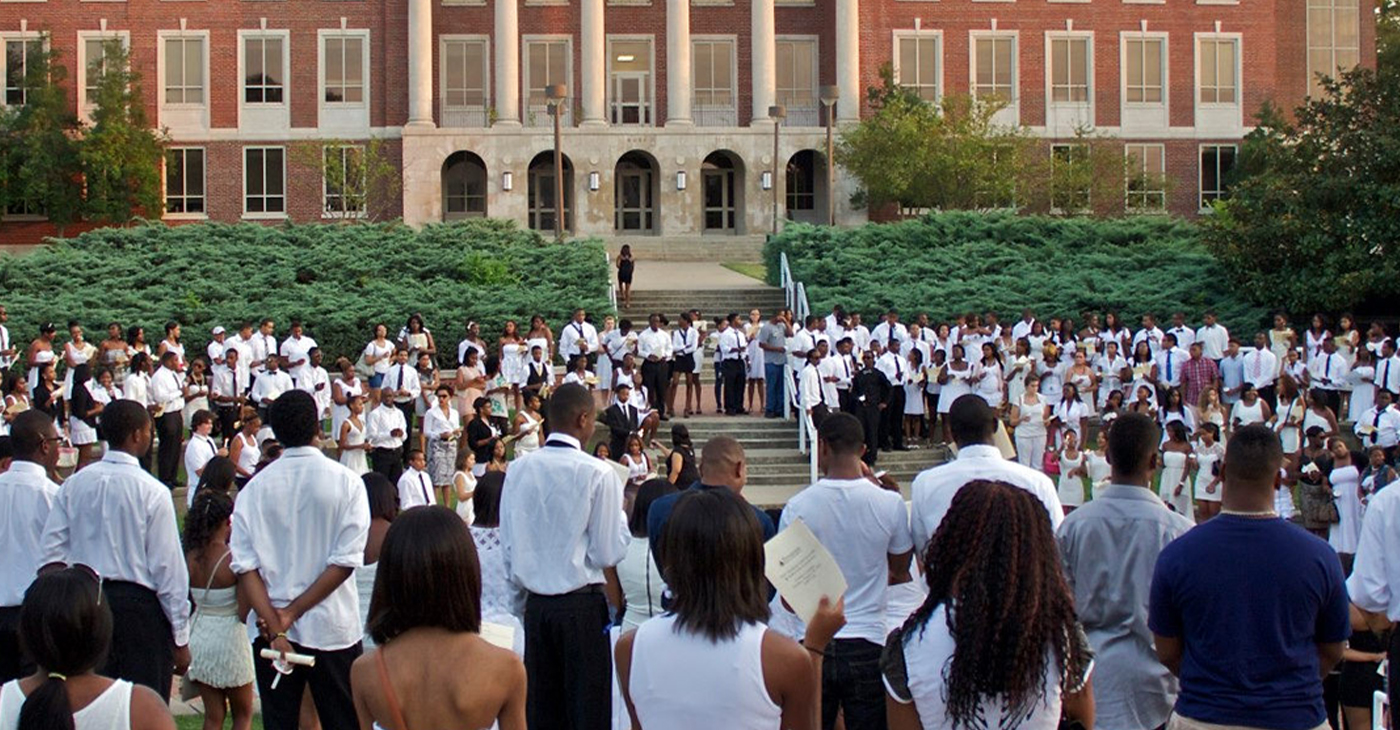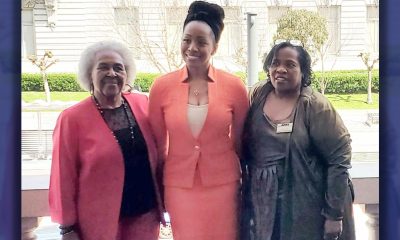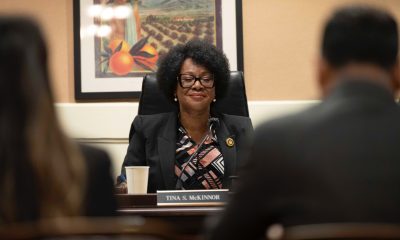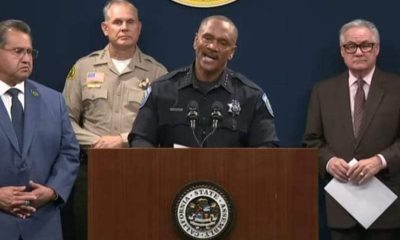#NNPA BlackPress
400 Years in Virginia. 500 Years in Slavery.
NNPA NEWSWIRE — Indeed, “the slave trade began in the 15th century,” said Boniface Chidyausiku of Zimbabwe in 2007, when he was the acting president of the United Nations General Assembly. Chidyausiku made the remarks during the UN’s observance of the 200th anniversary of the end of the transatlantic slave trade. “It was driven by colonial expansion, emerging capitalist economies and the insatiable demand for commodities – with racism and discrimination serving to legitimize the trade,” said Chidyausiku.
By Stacy M. Brown, NNPA Newswire Correspondent
@StacyBrownMedia
In August 2018, the National Newspaper Publishers Association began a series on the transatlantic slave trade.
The series started in conjunction with the annual United Nations International Day of Remembrance. With the observance of the first African landing in America, some question whether it’s the 400th or 500th anniversary.
Historians point out that the 400th anniversary is the 400th year of the Anglo-centric history of Africans in the Americas.
“Dating the history of Africans in North America to 400 years ago reinforces this narrative of English superiority,” Greg Carr, the Chair of the Department of Afro-American Studies at Howard University, told Time.com.
“Remembering the Spanish and indigenous sides of the history is more important now than ever as the people are closing the borders to those who are descendants from people who were here when you came,” Carr said.
In his 2013 PBS documentary, “The African Americans: Many Rivers to Cross,” Professor Henry Louis Gates, Jr., said slavery was always an essential ingredient of the American experiment. Gates called slavery, “The supreme hypocrisy,” and “capitalism gone berserk.”
The first African to come to North America was a free man who accompanied Spanish explorers to Florida in 1513 – or 106 years before the 20 Africans who were kidnapped and brought to Point Comfort, Va., in 1619, Gates said.
“The father of our country was one of its largest slave owners,” Gates said in the documentary.
“Because of the profound disconnect between principles of the Declaration of Independence and the Constitution and the simultaneous practice of slavery, we’ve had historical amnesia about slavery,” he said.
Indeed, the slave trade began in the 15th century, said Boniface Chidyausiku of Zimbabwe. It was driven by colonial expansion, emerging capitalist economies and the insatiable demand for commodities – with racism and discrimination serving to legitimize the trade, Chidyausiku said.
Chidyausiku, then the acting president of the United Nations General Assembly, made the remarks in 2007 during the UN’s observance of the 200th anniversary of the end of the transatlantic slave trade.
“Fortunes were made, and financial institutions flourished on the back of human bondage…[so] today’s commemoration must encourage everyone to live up to the Universal Declaration of Human Rights, which says: ‘All human beings are born free and equal in dignity and rights, and to redouble efforts to stop human trafficking and all forms of modern slavery,’” said Chidyausiku, who is now 69.
Michael Guasco, a historian at Davidson College and author of “Slaves and Englishmen: Human Bondage in the Early Modern Atlantic World,” suggests it’s the 500th anniversary.
“There’s a Hispanic heritage that predates the U.S., and there’s a tendency for people to willingly forget or omit the early history of Florida, Texas, and California, particularly as the politics of today want to push back against Spanish language and immigration from Latin America,” Guasco told Time.
The fact that slavery was underway for a century in South America before introduction in North America is not widely taught nor commonly understood, Felicia Davis of the HBCU Green Fund told NNPA Newswire.
“It is a powerful historical fact missing from our understanding of slavery, its magnitude, and global impact. The knowledge that slavery was underway for a century provides deep insight into how enslaved Africans adapted,” Davis said.
Far beyond the horrific “seasoning” description, clearly generations had been born into slavery long before introduction in North America, Davis said.
“This fact deepens the understanding of how vast majorities could be oppressed in such an extreme manner for such a long period. It is also a testament to the strength and drives among people of African descent to live free,” she said.
Prior to 1619, “America had a system of discrimination and prejudice against all groups who were not identified as White Anglo-Saxon native,” said Walter D. Palmer, who started a Community Freedom School for children and adult learners in Philadelphia that would become the platform on which he built his social legacy.
“By the mid-1600s, America created the slave codes,” Palmer told NNPA Newswire.
During the country’s founding, many settlers learned from and lived close to Native Americans on the east coast, said author Cassie Premo Steele.
For example, it wasn’t until resources like silver were found on what was Cherokee land that Andrew Jackson ordered the removal that became known as the “Trail of Tears,” Steele told NNPA Newswire.
“Further genocides and removals took place in the West when similar resources and land were desired by white Americans,” Steele said.
“Similarly, slavery was primarily an economic system that was based upon the dehumanization of Africans. Dehumanization is in some ways even worse than hate since it is a denial of the humanity of a people,” she said.
The observance of the 400th anniversary of the first African landing at Point Comfort, Va., did bring about changes, according to Time.
It was the type of race-based chattel slavery system that solidified in the centuries that followed was its unique American tragedy.
A letter on file at the Library of Congress from early English settler John Rolfe noted that a century before August 1619, the transatlantic slave trade had been active.
The letter noted that hundreds of thousands of Africans helped with the establishment and survival of American colonies in the New World.
According to History.com, Rolfe was correct.
History.com reported that Christopher Columbus likely transported the first Africans to the Americas in the late 1490s on his expeditions to Hispaniola.
“To ignore what had been happening with relative frequency in the broader Atlantic world over the preceding 100 years or so understates the real brutality of the ongoing slave trade, of which the 1619 group were undoubtedly a part, and minimizes the significant African presence in the Atlantic world to that point,” Guasco said in a History.com interview earlier this month.
“People of African descent have been ‘here’ longer than the English colonies,” he said.
#NNPA BlackPress
IN MEMORIAM: Ramona Edelin, Influential Activist and Education Advocate, Dies at 78
NNPA NEWSWIRE — Born on September 4, 1945, in Los Angeles, California, activist Ramona Edelin’s early years were marked by a commitment to education and social justice. According to her HistoryMakers biography, after graduating from Fisk University with a Bachelor’s degree in 1967, she pursued further studies at the University of East Anglia in England. She earned her master’s degree before completing her Ph.D. at Boston University in 1981.
The post IN MEMORIAM: Ramona Edelin, Influential Activist and Education Advocate, Dies at 78 first appeared on BlackPressUSA.

By Stacy M. Brown, NNPA Newswire Senior National Correspondent
@StacyBrownMedia
Once upon a time, Black Americans were simply known as colored people, or Negroes. That is until Ramona Edelin came along. The activist, renowned for her pivotal roles in advancing civil rights, education reform, and community empowerment, died at her D.C. residence last month at the age of 78. Her death, finally confirmed this week by Barnaby Towns, a communications strategist who collaborated with Dr. Edelin, was attributed to cancer.
Born on September 4, 1945, in Los Angeles, California, Edelin’s early years were marked by a commitment to education and social justice. According to her HistoryMakers biography, after graduating from Fisk University with a Bachelor’s degree in 1967, she pursued further studies at the University of East Anglia in England. She earned her master’s degree before completing her Ph.D. at Boston University in 1981.
Edelin’s contributions to academia and activism were manifold. She was pivotal in popularizing the term “African American” alongside Rev. Jesse L. Jackson in the late 1980s.
Jackson had announced the preference for “African American,” speaking for summit organizers that included Dr. Edelin. “Just as we were called Colored, but were not that, and then Negro, but not that, to be called Black is just as baseless,” he said, adding that “African American” “has cultural integrity” and “puts us in our proper historical context.”
Later, Edelin told Ebony magazine, “Calling ourselves African Americans is the first step in the cultural offensive,” while linking the name change to a “cultural renaissance” in which Black Americans reconnected with their history and heritage.
“Who are we if we don’t acknowledge our motherland?” she asked later. “When a child in a ghetto calls himself African American, immediately he’s international. You’ve taken him from the ghetto and put him on the globe.”
The HistoryMakers bio noted that Edelin’s academic pursuits led her to found and chair the Department of African American Studies at Northeastern University, where she established herself as a leading voice.
Transitioning from academia to advocacy, Edelin joined the National Urban Coalition in 1977, eventually ascending to president and CEO. During her tenure, she spearheaded initiatives such as the “Say Yes to a Youngster’s Future” program, which provided crucial support in math, science, and technology to youth and teachers of color in urban areas. Her biography noted that Edelin’s efforts extended nationwide through partnerships with organizations like the National Science Foundation and the United States Department of Education.
President Bill Clinton recognized Edelin’s expertise by appointing her to the Presidential Board on Historically Black Colleges and Universities in 1998. She also co-founded and served as treasurer of the Black Leadership Forum, solidifying her standing as a respected leader in African American communities.
Beyond her professional achievements, Edelin dedicated herself to numerous boards and committees, including chairing the District of Columbia Educational Goals 2000 Panel and contributing to the Federal Advisory Committee for the Black Community Crusade for Children.
Throughout her life, Edelin received widespread recognition for her contributions. Ebony magazine honored her as one of the 100 Most Influential Black Americans, and she received prestigious awards such as the Southern Christian Leadership Award for Progressive Leadership and the IBM Community Executive Program Award.
The post IN MEMORIAM: Ramona Edelin, Influential Activist and Education Advocate, Dies at 78 first appeared on BlackPressUSA.
#NNPA BlackPress
Tennessee State University Board Disbanded by MAGA Loyalists as Assault on DE&I Continues
NNPA NEWSWIRE — Recent legislative actions in Tennessee, such as repealing police reform measures enacted after the killing of Tyre Nichols, underscore a troubling trend of undermining local control and perpetuating racist agendas. The new law preventing local governments from restricting police officers’ authority disregards community efforts to address systemic issues of police violence and racial profiling.
The post Tennessee State University Board Disbanded by MAGA Loyalists as Assault on DE&I Continues first appeared on BlackPressUSA.

By Stacy M. Brown, NNPA Newswire Senior National Correspondent
@StacyBrownMedia
Tennessee State University (TSU), the state’s only public historically Black college and university (HBCU), faces a tumultuous future as Gov. Bill Lee dissolved its board, a move supported by racist conservatives and MAGA Republicans in the Tennessee General Assembly, who follow the lead of the twice-impeached, four-times indicted, alleged sexual predator former President Donald Trump. Educators and others have denounced the move as an attack on diversity, equity, and inclusion (DE&I) and a grave setback for higher education.
Critics argue that TSU’s purported financial mismanagement is a manufactured crisis rooted in decades of underinvestment by the state government. They’ve noted that it continues a trend by conservatives and the racist MAGA movement to eliminate opportunities for Blacks in education, corporate America, and the public sector.
Gevin Reynolds, a former speechwriter for Vice President Kamala Harris, emphasizes in an op-ed that TSU’s financial difficulties are not the result of university leadership because a recent audit found no evidence of fraud or malfeasance.
Reynolds noted that the disbanding of TSU’s board is not an isolated incident but part of a broader assault on DE&I initiatives nationwide. Ten states, including Tennessee, have enacted laws banning DE&I policies on college campuses, while governors appointing MAGA loyalists to university trustee positions further undermine efforts to promote inclusivity and equality.
Moreover, recent legislative actions in Tennessee, such as repealing police reform measures enacted after the killing of Tyre Nichols, underscore a troubling trend of undermining local control and perpetuating racist agendas. The new law preventing local governments from restricting police officers’ authority disregards community efforts to address systemic issues of police violence and racial profiling.
The actions echo historical efforts to suppress Black progress, reminiscent of the violent backlash against gains made during the Reconstruction era. President Joe Biden warned during an appearance in New York last month that Trump desires to bring the nation back to the 18th and 19th centuries – in other words, to see, among other things, African Americans back in the chains of slavery, women subservient to men without any say over their bodies, and all voting rights restricted to white men.
The parallels are stark, with white supremacist ideologies used to justify attacks on Black institutions and disenfranchise marginalized communities, Reynolds argued.
In response to these challenges, advocates stress the urgency of collective action to defend democracy and combat systemic racism. Understanding that attacks on institutions like TSU are symptomatic of broader threats to democratic norms, they call for increased civic engagement and voting at all levels of government.
The actions of people dedicated to upholding the principles of inclusivity, equity, and justice for all will determine the outcome of the ongoing fight for democracy, Reynolds noted. “We are in a war for our democracy, one whose outcome will be determined by every line on every ballot at every precinct,” he stated.
The post Tennessee State University Board Disbanded by MAGA Loyalists as Assault on DE&I Continues first appeared on BlackPressUSA.
#NNPA BlackPress
Braxton Haulcy and the Expansion of Walker|West Music Academy
May 24, 2023 – Walker West Music Academy gets an early start on expansion. Join us for a Wednesday episode of The …
The post Braxton Haulcy and the Expansion of Walker|West Music Academy first appeared on BlackPressUSA.

May 24, 2023 – Walker West Music Academy gets an early start on expansion. Join us for a Wednesday episode of The …
The post Braxton Haulcy and the Expansion of Walker|West Music Academy first appeared on BlackPressUSA.
-

 Activism4 weeks ago
Activism4 weeks agoOakland Post: Week of March 27 – April 2, 2024
-

 #NNPA BlackPress4 weeks ago
#NNPA BlackPress4 weeks agoBeloved Actor and Activist Louis Cameron Gossett Jr. Dies at 87
-

 Community1 week ago
Community1 week agoFinancial Assistance Bill for Descendants of Enslaved Persons to Help Them Purchase, Own, or Maintain a Home
-

 Activism3 weeks ago
Activism3 weeks agoOakland Post: Week of April 3 – 6, 2024
-

 Business2 weeks ago
Business2 weeks agoV.P. Kamala Harris: Americans With Criminal Records Will Soon Be Eligible for SBA Loans
-

 Activism2 weeks ago
Activism2 weeks agoOakland Post: Week of April 10 – 16, 2024
-

 Community1 week ago
Community1 week agoAG Bonta Says Oakland School Leaders Should Comply with State Laws to Avoid ‘Disparate Harm’ When Closing or Merging Schools
-

 Community6 days ago
Community6 days agoOakland WNBA Player to be Inducted Into Hall of Fame






















































